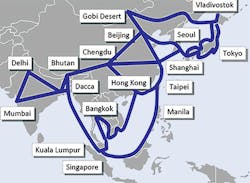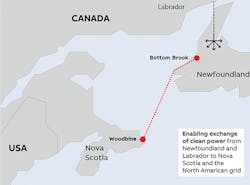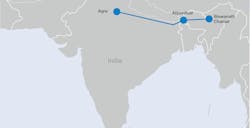The electric utility industry is shifting from large centrally located fossil-fuel generation plants to a more environmentally friendly grid powered by renewable energy sources, such as wind, solar, geothermal and hydropower. While renewables are helping to reduce the industry’s carbon footprint, they bring new issues and challenges, such as the grid itself. Designed more than a century ago, the legacy grid is a patchwork of transmission lines spreading from city to city, but it was optimized for the requirements of the day, which were totally different than today’s power-delivery system. Despite all the issues facing the 21st century grid, one of the most transformative developments is poised to impact the grid: large-scale electricity interconnections.
Worldwide, weak connections are still a significant issue in many parts of the world. They are having an inordinate effect on the modernization process of the power-delivery system. The weaker connections reduce the grid’s ability to maintain the instantaneous balance between electricity supply and demand. This is especially true where there are large deployments of wind and solar generation. More than one study has noted demand patterns should be considered when linking various regions, for example, linking winter peaking areas with summer peaking regions and considering different times zones to smooth variabilities. When the grid was designed, these demand patterns were not an issue.
Bigger Is Better
The modern concept of a globally large-scale electricity interconnection has been grabbing the world’s attention at seminars, conferences, webinars and technical gatherings. A wide variety of industry experts are proposing a grid that is dynamic, has more flexibility and is resistant to all types of blackouts, service interruptions and disturbances. This would require the grid to be more interconnected than ever before, which is a considerable technological challenge requiring many different technologies, from multiple manufacturers, to be integrated to work together seamlessly.
All the technology exists, but grid operators and utilities need to initiate the process. It would be great to say the industry has a detailed plan, but rather, it will be driven by economics and system requirements one initiative at a time. It is important to understand where the grid is heading and plan accordingly. Interestingly, the makeup of this next-generation grid has caught both the attention and imagination of industry experts. Their interest has flared into a spirited dialogue with diverse solutions covering a variety of subject matter, which highlights the pending changes in store for the grid.
Puzzle Pieces
Some of these discussions have centered around the fact a great deal of the grid’s infrastructure has aged well beyond its design life, and pundits say the equipment needs to be updated before anything else is done. Other conversations have focused on the deployment of advanced digital technologies first and then work on the interconnection issue second. Another school of thought says today’s grid already is too large and needs to be split up into smaller, more manageable units.
Many feel the solution would be to incorporate each of these pieces into an integrated grid but do so in a bite-sized piece that is better defined than many of the plans. One of the more promising ideas is something called the mega grid, which basically is a wide-area alternating-current (AC) transmission network. The mega grid makes it possible to trade high volumes of electricity over great distances, but there are limitations to AC due to losses, control issues and congestion. This brings up an interesting proposal: address the issues by combining high-voltage direct-current (HVDC) technology with the AC transmission system.
Grid Sense
Essentially, the idea is to make a more efficient power-delivery system by improving the AC transmission grid by applying power electronics technologies. In its simplest form, the mega grid has the traditional AC grid integrated with an HVDC superstructure. However, the mega grid scenario is somewhat different than the intermix HVDC facilities already incorporated into the AC grid. The integrated AC-DC grid has been compared to the interstate highway system, separated from regional highways, roads and streets. Many special interest groups trying to gain recognition have coined an overabundance of names, which has added to the confusion. The terms run the gamut from superior grid, super smart grid, integrated AC-DC transmission system and regional grid to super grid, global grid, macro grid and so on.
Navigant Research has a good definition of the mega grid: "The transmission network required to transport high volumes of power across long distances in order to optimize resource use, improve operational efficiency and integrate renewable power from remote regions where the resource potential is strongest."
In addition, according to Navigant, adding HVDC transmission lines to this plan enables the mega grid to move large amounts of renewable energy independent of the AC grid, avoiding congestion and other problems associated with AC. "The Transmission System Upgrades for Renewable Energy Integration" report by Navigant predicts, "Global HVDC revenue is expected to grow at a compound annual growth rate of 9.5% from 2016 to 2025 and reach $12.7 billion by 2025."
Navigant estimates more than 200 GW of HVDC capacity now exists globally. In addition, the report estimates 65 mega grid projects heavily leveraging HVDC are in development or being planned around the world.
HVDC Is the Glue
There are many good texts on the history of HVDC technology. For the sake of this discussion, this history will be simplified. When ASEA (now ABB) commissioned the world’s first HVDC undersea power link between the Swedish mainland and the island of Gotland in 1954,it was the beginning of modern commercialized HVDC technology. It set the stage for widespread deployment of point-to-point HVDC schemes, but the technology was limited. In the 1970s the thyristor was invented and it quickly became a core component in the HVDC system technology.
Then in the late 1990s, the thyristor was joined by another solid-state technology, the insulated-gate bipolar transistor (IGBT). IGBT gave manufacturers a fully controllable semiconductor switch and utilities a new HVDC scheme. With the addition of the IGBT technology, the first VSC HVDC was developed by ASEA, and in 1999, the first commercial link was up and running. Users now have two basic forms of HVDC schemes: classic HVDC technology, known as the line-commutated converter (LCC) using thyristors; and voltage source converter (VSC) using IGBTs.
LCCs are used primarily for bulk electrical transmission over long distances and interconnecting separate power grids where conventional AC methods are not suitable. LCC typically has a high power rating between 3000 MW and 11,000 MW.
VSC technology initially was used for smaller links, but it now has advanced to power levels up to 640 kV and 3500 MW. VSCs are suited especially for grid connections, offshore wind farm links, strengthening power networks, and powering oil and gas platforms.
Old Dog, New Tricks
Combining LCC power ratings with VSC flexibility is a huge plus for integrating DC into the AC grid. These schemes are giving life to old theories such as a multinational electric grid connecting countries and continents to bring each other new life. The technologies also are proving to be a powerful force and reshaping the ideas of improved power-delivery grids. In addition to developments in VSC applications, research and development has pushed voltages for traditional LCC applications into ultra-high-voltage direct current (UHVDC), which can deliver up to 12 GW of power. UHVDC also has expanded transcontinental distances by more than 3000 km (1865 miles) and taken voltages up to ±1100 kV.
LCC and VSC schemes have been laying the groundwork for mega grids worldwide in a variety of projects, using HVDC technologies to move toward the mega grid one step at a time. Countries such as China, India and Brazil are deploying
UHVDC technology, with a wide variety of projects pushing the technological envelope.
So far, no actual mega grid projects have been built. However, China has really embraced the HVDC backbone concept and moved forward into the realm of UHVDC. China does not face the regulatory barriers with HVDC and UHVDC technologies that are in place in North America and Europe. As a result, China is farther along than the rest of the world in building the beginnings of a mega grid with HVDC and UHVDC transmission schemes. Following are a few examples of the work taking place.
Laying the Groundwork
State Grid Corporation of China (SGCC) along with ABB, the main technology supplier, put the world’s first UHVDC transmission scheme into commercial service in 2010. At the time, the line was one of the world’s longest overhead lines, running almost 2000 km (1243 miles) long and transmitting power from Xiangiaba to Shanghai. The capacity of the line was 6400 MW, which also was a record breaker. In addition, it offered a benefit of lower line losses. The ±800-kV technology’s lower losses were comparable to conventional ±500-kVDC transmission lines.
By mid-2017, China had built and commissioned nine ±800-kV transmission lines, but that was not the entire story. SGCC also reported it had begun construction of the Changji-Guquan UHVDC link, which the utility expects to commission in 2018. This UHVDC transmission line runs from the coal- and wind-rich region of Xinjiang in the far northwest to the Anhui province in the east. The UHVDC transmission link will be rated ±1100 kV and 12 GW, a 50% increase over the transmission capacity of the ±800-kV UHVDC links currently in operation.
As part of this project, the world’s first 1100-kV UHVDC transformer was developed. The transformer passed its type testing, which confirmed its design criteria and operating parameters. The transformers are scheduled to be commissioned in 2018 as part of the Changji-Guquan link. It is estimated if China continues to deploy its HVDC links as planned, it will account for nearly 60% of the world’s installed HVDC transmission capacity.
India also has been committed to building HVDC transmission. With the first components installed about 25 years ago, India now has several operational HVDC schemes and more are being planned. One project that has direct influence in the mega grid discussion is the North-East Agra project, scheduled for completion in 2019. ABB reported, "Northeast India has abundant untapped hydropower resources scattered over a large area, but load centers are hundreds or even thousands of kilometers away."
Power must pass through a very narrow patch of land — 22 km wide by 18 km long (14 miles by 11 miles) — in the state of West Bengal, which borders Nepal on one side and Bangladesh on the other, and is referred to as the chicken neck area. ABB refers to this area as a power superhighway. The company also stated, "The ±800-kV North-East Agra UHVDC link will have a record 8000-MW converter capacity, including a 2000 MW redundancy, and transmit clean hydroelectric power from India’s northeast region to the city of Agra, a distance of 1728 km [1074 miles]."
Another project helping to move the industry closer to the mega grid concept is ScottishPower Ltd. and National Grid plc’s Western HVDC link, being built by a consortium of Siemens and Prysmian Group. Intended to bring renewable energy from Scotland to England and Wales, the link will be the world’s first 600-kV, 900-MW submarine HVDC network, with 385 km (239 miles) underwater transmission out of 421 km (262 miles) total project miles. Subsea cables can be installed relatively easily and with minimum disruptions.
It is estimated that when the GBP1 billion (US$1.34 billion) joint venture between National Grid and ScottishPower Transmission is fully operational, the 2.2-GW project will increase capacity between Scotland and England to more than 6 GW. This will ease the traditional transmission bottlenecks between these countries and reduce constraints on Scottish wind farms.
Next Steps
As an industry, we have made great progress with the advancement of HVDC and UHVDC technologies, but, for a long time, one critical element was missing in the quest to achieve an AC-DC mega grid: an HVDC circuit breaker. Manufacturers have been working on this device almost since the beginning of the industry, but it has only been recently that materials science has caught up with theory, making the HVDC circuit breaker possible.
In 2014, ABB announced a breakthrough in IGBT technology that enabled a hybrid DC breaker. The hybrid breaker is fast enough to interrupt current and robust enough to isolate faults. It combines mechanical and power electronics switching that lets it interrupt quickly. Without going into a lot of detail, the hybrid HVDC breaker uses IGBT valve technology to block and break DC currents of thousands of amperes and several hundred thousand volts. A short time after ABB’s announcement, GE stated it, too, had a hybrid HVDC circuit breaker as did several Chinese manufacturers. When all the point-to-point HVDC and UHVDC projects are considered, the hybrid circuit breaker represents the next logical step in connecting these schemes into the mega grid being discussed throughout the industry.
The DC network toolbox has everything needed for the development of the mega grid. Now a project is needed to move the industry from discussion and planning to reality, but that step is proving to be the biggest challenge for all involved. There has been no lack of imaginative mega grid proposals. Proposals such as the pan-European HVDC network, the Asia super grid, the Nordic grid and IceLink show the world is interested in mega grid projects. It is only a matter of time before a country or group of countries takes existing HVDC and UHVDC transmission schemes and combines them with hybrid circuit breakers to form networks of DC into AC grids.
The technology is available. It has matured to the point an HVDC grid is going to happen. At the 2018 IEEE PES T&D Conference & Expo, a lot of discussion centered on the advantages of combining the AC grid with a DC network. In addition to ABB and GE having displays of the hybrid DC circuit breaker, several Chinese manufacturers were talking about their designs. One manufacturer, NARI Group Corp., had a model of its DC circuit breaker on display. China could be the first country to integrate its extensive HVDC and UHVDC schemes into the world’s first AC-DC mega grid. No matter who initiates the first mega grid, it is going to be an ambitious enterprise, but it is an undertaking whose time has come. ♦
About the Author
Gene Wolf
Technical Editor
Gene Wolf has been designing and building substations and other high technology facilities for over 32 years. He received his BSEE from Wichita State University. He received his MSEE from New Mexico State University. He is a registered professional engineer in the states of California and New Mexico. He started his career as a substation engineer for Kansas Gas and Electric, retired as the Principal Engineer of Stations for Public Service Company of New Mexico recently, and founded Lone Wolf Engineering, LLC an engineering consulting company.
Gene is widely recognized as a technical leader in the electric power industry. Gene is a fellow of the IEEE. He is the former Chairman of the IEEE PES T&D Committee. He has held the position of the Chairman of the HVDC & FACTS Subcommittee and membership in many T&D working groups. Gene is also active in renewable energy. He sponsored the formation of the “Integration of Renewable Energy into the Transmission & Distribution Grids” subcommittee and the “Intelligent Grid Transmission and Distribution” subcommittee within the Transmission and Distribution committee.







